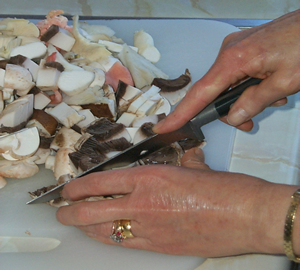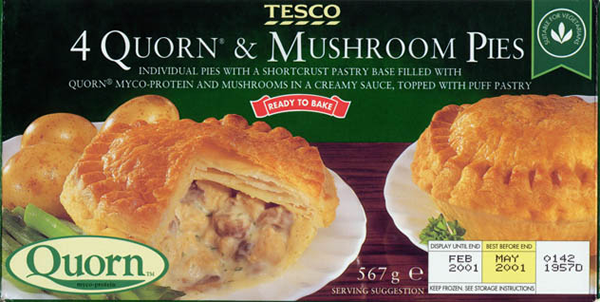1.2 What use is Kingdom Fungi?
Our use of fungi is usually hidden from view, so the way we most often directly encounter useful fungi is as part of a meal of mushrooms!
 |
 |
All photographs © David Moore 2011 |
|
Mushroom cultivation is important, and I will say more about it below, but it's not the only way we can and do make use of fungi. For example, if fungal pathogens have adverse effects on agriculture, why not use pathogens to attack plants that we don't want to cultivate?
In agriculture, fungal pathogens may be useful for the biological control of weeds. In the United States, 13 of the top 15 weeds are introduced species, and in Canada, 78 of the 107 most troublesome weeds were introduced to the country. The best way to control such alien plants is to introduce diseases from their home territories. This policy has a 67% overall success rate.
This photograph is an illustration of experimental plots showing how application of spores of Colletotrichum gloeosporioides f.sp. malvae effectively controls the weed Malva pusilla, a serious weed of crops such as flax. |
 |
There is scope for much more aggressive Biological Control. Maybe we could use fungal diseases in the drugs war?
For example, Fusarium oxysporum against cocaine plantations ...
Videostills from Panorama: Britain’s Secret War on Drugs © BBC 2000 |
... or Pleospora papaveracea against heroin poppies:
Videostills from Panorama: Britain’s Secret War on Drugs © BBC 2000 |
Such biological agents can achieve 99% destruction of the target - and they are highly specific to the one host. These activities raise important questions of ethics (because they amount to biological warfare), not to mention delicate international politics (drug producing countries are unlikely to invite ‘attacks’ on their own territory). And it’s a very small step from targeting a narcotics crop to targeting a food crop.
But the tools are there.
Biological Control can be used against other pests:
 |
 |
 |
| Weevil... | ...spruce budworm larvae killed by Metarhizium... | ...Mycar is a mycoacaricide used to prevent the build-up of populations of citrus rust mite. |
| Images from The Fifth Kingdom by Bryce Kendrick, Mycologue Publications | ||
Humans have been using fungi for many thousands of years. This is the corpse of Ötzi, the Ice Man:
 |
Image from James M. Deem’s website Mummy Tombs at http://www.mummytombs.com; see also the Wikipedia entry. |
Over 5,000 years ago this Neolithic traveller set out across the Alps but he died in the ice and snow, and his corpse was preserved in the glacier to be exposed eventually at the edge of the ice sheet in 1991, close to the Austrian-Italian border. A remarkable feature of the Iceman’s equipment is that it included three separate fungal products. One was a mass of fibrous material of a fungus with a long history of use as a tinder, so clearly it was part of the Iceman’s fire-making kit. The other two were pieces of a bracket fungus threaded onto leather thongs. The fungus (actually called Piptoporus betulinus) is known to accumulate antiseptics and chemicals (known as secondary metabolites) able to reduce fatigue and sooth the mind. Perhaps they were chewed on when the going got tough on his trek over the Alps.
Today's fungal products
Today, alcohol and citric acid are the world’s most important fungal metabolites in terms of production volume, although, penicillin is still an important antibiotic. Most antibiotics that we use today actually originate from bacteria, but fungi produce some other useful pharmaceuticals.
- The fungal product called cyclosporin is capable of suppressing the immune response in transplant patients so as to avoid organ rejection.
- Another natural compound obtained from fungi that has great medical value is called mevinolin. This is produced by the fungus Aspergillus terreus and is the basis of the ‘statins’ which are used to reduce cholesterol levels (high cholesterol levels being considered to be a risk factor in heart disease).
- Three compounds derived from mevinolin, Pravastatin, Simvastatin and Lovastatin, had worldwide sales that put them individually in the top ten selling pharmaceuticals, with combined sales valued at well over 5 billion U.S. dollars.
Some other fungal products
Most of the steroids in clinical use today are modified during manufacture by using fungi to make specific chemical transformations that may avoid anything up to twenty or thirty steps of pure chemistry. Using fungi in this way allows specific compounds to be made which would be otherwise very difficult, impossible, or just too expensive to produce by direct chemical synthesis.
Ergot toxins in low, and controlled, concentrations are valuable drugs causing dilation of veins and a decrease in blood pressure as well as contraction of smooth muscles. The ergot alkaloids are now produced by fermentation.
Many fungal products have been found to inhibit the growth of cancers in animal tests. Specificity and safety limit the medical usefulness of most of these compounds (they may have adverse effects on healthy tissue as well as the tumour). Compounds that work by modifying the activity of the patient’s own immune system (immunomodulators) - making it more active against the cancer cells - seem likely to offer the greatest value.
Mushroom cultivation is the most obvious way in which we exploit fungi
Mushroom growers expect to harvest between three and five flushes from each spawning cycle, with a total yield of around 25 kg m-2 of growing tray. After the final pick (7 to 10 weeks after spawning) the compost is spent, and the cropping room is emptied, cleaned, sterilised and filled with the next crop. On most large commercial farms a new crop is filled every 1 or 2 weeks throughout the year. So a mushroom farmer is likely to see more crops in one year than a cereal farmer will see in a lifetime.
Commercial production of mushrooms produces a total crop of several million metric tonnes each year. In the mid-1970s the button mushroom (Agaricus) accounted for over 70% of total global mushroom production. Today, it accounts for something closer to 45% even though production tonnage has increased 12-fold in the intervening years. At averaged-out prices this total crop currently has an annual retail value of about US$50 billion.
‘Exotic’ mushrooms (like Lentinula and Pleurotus) are now routinely found alongside Agaricus in shops and supermarkets around the world.
 |
Agaricus, Lentinula and three species of Pleurotus shop-bought cultivated fungi. © David Moore 2011 |
More details about mushroom farming can be found in other parts of this website; the topic is also discussed in the textbook 21st Century Guidebook to Fungi.
Fungi as food
All fungi, yeasts, filamentous fungi and mushrooms, make good food because they:
- have a good content of protein (20-30% of dry matter) that contains all the essential amino acids;
- have chitinous walls as a source of dietary fibre;
- contain B-vitamins;
- are low in fat;
- and are free of cholesterol.
Don't just think of mushrooms as flavourful delicacies. Other fungal products, hold great promise as "front-line" foods, and Quorn™ mycoprotein
(made from the mycelium of Fusarium venenatum) shows what can be achieved:
 |
| Fungus mycelium pretending to be lamb, beef or chicken. Quorn™ and the Quorn™ logo are trademarks of Marlow Foods Ltd. |
Two of the world’s largest continuous flow culture systems are used to produce the Quorn™ mycoprotein
. Each fermentation tower is 50 m tall and 155,000 litre capacity. Installation was completed in May 1994.
 |
| More Quorn™ mycoprotein products - cook-it-yourself pieces, a more exotic meal, and the technical triumph of a range of sliced cooked meat alternatives. Quorn™ and the Quorn™ logo are trademarks of Marlow Foods Ltd. |
And I think this could be the ultimate fungal food:
|
| Ingredients: Fusarium, Agaricus and yeast! What more could you want? Quorn™ and the Quorn™ logo are trademarks of Marlow Foods Ltd. |
Ganoderma is cultivated, but not for food. Ganoderma is naturally variable. On the tree trunk it grows like a bracket, without a stem. On the tree roots it forms a stem.
 |
| On the tree trunk Ganoderma grows like a bracket, without a stem. On the tree roots it forms a stem. Photographed by Dr S.W. Chiu. |
Ganoderma is cultivated, but not as a food ... because Ganoderma is used in traditional Chinese medicinal remedies:
 |
 |
There is now a significant world trade in picked or collected mushrooms. The world market for chanterelles (collected, not cultivated) was estimated recently at more than US$ 1.5 × 109.
The commercial picking industry has now expanded to a system of harvesters, buyers, processors, and brokers. Harvesters locate and pick the mushrooms. Buyers, typically associated with a specific processor, set up buying stations near wooded areas known to produce mushrooms and advertise their willingness to buy.
Processors grade, clean, pack, and ship the product while providing the cash directly to the field workers. Brokers market the mushrooms around the world. This is a model which has become common in Europe and the United States. One of the things that makes it viable is the easy access to rapid trans- and intercontinental transport. As transport and communications continue to improve, the commercial picking industry is bound to continue to expand.
More research needed
Any attempt to apply physiological, biochemical, and even many genetic studies to crop production depends on intimate knowledge of tissue interactions during development. Yet there is an astonishing depth of ignorance about the basic structure of fruit bodies and their developmental biology. Look elsewhere on this website (see Section 4) for more pages dealing with mushroom development and morphogenesis. I've written a book about this called Fungal Morphogenesis.
The topic of this Section is also discussed in Chapters 11, 12, 17 and 18 of the textbook 21st Century Guidebook to Fungi.
Updated December 7, 2016





